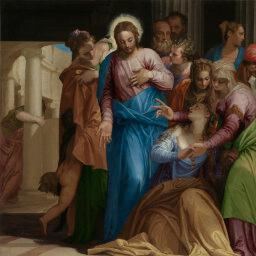Year 1545- 1548 | Medium Oil on canvas | |
 | ||
Dimensions 163.5 cm × 117.5 cm (64.4 in × 46.3 in) Similar Paolo Veronese artwork, Other artwork | ||
The Conversion of Mary Magdalene is an oil painting, an early work by the Italian Renaissance artist based in Venice, Paolo Veronese (1528–1588). He was known for his sumptuous paintings with a dramatic and colourful style. Dating from circa 1545–1548, the painting was commissioned by a noble patron in Verona.
Contents
Subject
The subject of the painting was debated, and the general opinion is that it depicts the conversion of Mary Magdalene, according to Pietro Aretino's book description of this scene in his work L'umanità di Cristo from 1535. The book was a version of the Gospels that was widely distributed and read in Northern Italy at this time.
Painting
The scene that the painting depicts is an event that is not described in the Bible or the Golden Legend. Martha and Mary Magdalene are in the Temple where Jesus is preaching. Mary Magdalene is on her knees beside Christ, turning her face towards him, while Martha is extending her hands towards Christ and Mary Magdalene. Her luxurious dress is pointing to her vanity and her sinfulness, that she will renounce now, converted by this encounter. Paolo Veronese was known for his depictions of luxurious settings and love of decorating the most holy and sacred of scenes with people clad in shimmering fur-lined gowns made of silks and brocades, more reminiscent of Venetian high society than humble representations of the subjects. When the Inquisition questioned his choice of representing holy subjects he answered: "we painters take liberties, the same way that poets and lunatics do", asserting his liberty as an artist in his choice of representing his subjects.
